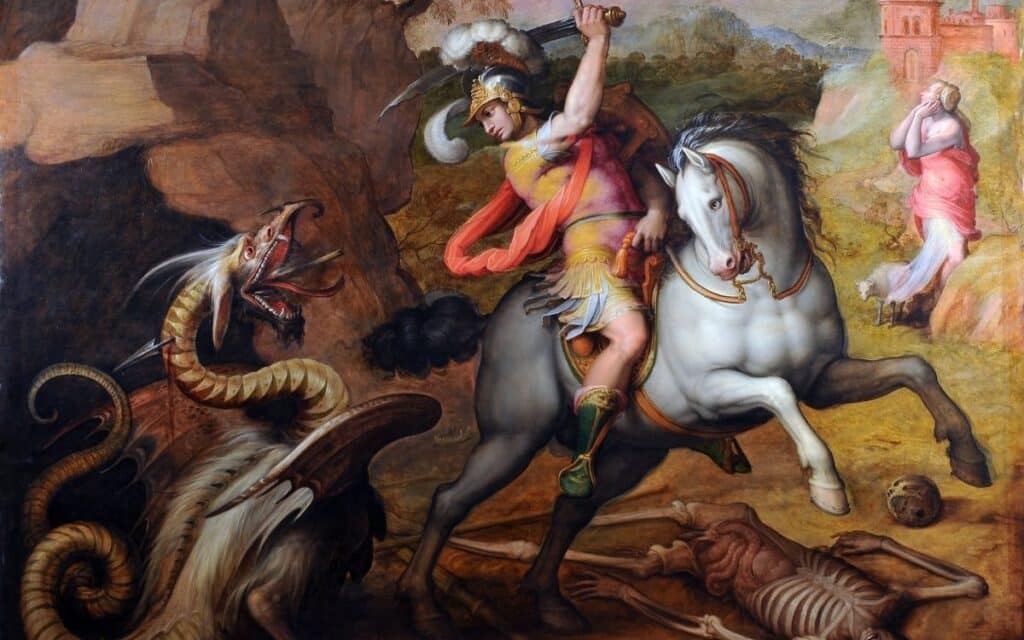St George is celebrated all over England on 23 April each year, but he has more to him than just slaying dragons, says CALLUM CAMPBELL

On the 23rd of April, each and every year, folk flock to the streets clothed in red and white in St George’s Day Parades all across England. These events commemorate the life and death of England’s patron saint St George, purge of dragons and trumpeter of Christianity.
Here are 10 facts about this icon of English culture that will tickle your mind’s taste buds.
Facts about St George
- St George is a national hero of England, however, his blood isn’t even remotely English. George of Lydda was born sometime in the 3rd century AD in the Turkish province of Cappadocia to Greek-Christian parents. His father died for his faith when George was at the tender age of 14, somewhat foreshadowing his own unfortunate death many years later. In fact, St George never ventured into England at any point through his life. It was only through his widespread fame and praise throughout Europe that he reached the ears of the English.
- Although St George is primarily seen as an prominent icon of English culture and heritage, the English share this important and holy figure with many other nations throughout the world such as Portugal and Ethiopia as well as many cities and regions including Venice, Genoa and Catalonia.
- St George is seen as a powerful, pious helper to the people of the earth, often being called on to help with just military conquests and serious epidemics of diseases such as plague and leprosy. Perhaps his most famous spiritual exploit was during the brutal Battle of Mons in World War One. British troops were outnumbered by the Germans near five to one, however, against all odds, they managed to fight their way through the horde. Many soldiers prescribe their victory against an insurmountable mountain to a group of spectral archers, said to be angels, headed by St George.
- St George’s fierce and selfless fighting for good was not limited to his being in spirit, for in his life, he achieved many triumphs of great renown. The most famous was said to be the slaying of a dragon that terrorised the city of Silene, located in Libya, in the 3rd century AD. The story goes that in Silene, a great dragon with poison that smogged from its mouth infected the countryside around Silene and demanded the sacrifice of children as “payment” for not savaging the city. One day, the king’s daughter was chosen to be the dragon’s meal. Just before the beast crunched down on her head, St George arrived on the scene, brandished the Sign of the Cross at it then mightily struck it down with his lance, then bridled it and paraded it through the streets. He convinced the population to convert to Christianity then slaughtered the dragon. On the spot on which it was slain, a holy fount sprung from the ground from which ran water said to heal any ailment or injury.
- St George attained such fame and popularity among the common folk that they severely exaggerated the stories of his execution for being Christian to the point the church had to ban the most ludicrous accounts of his death out of embarrassment. Perhaps the most asinine account of his death was that over a period of seven years he was: torn apart on the rack, beat over the skull with mallets until his brains leaked out, was forced to chug poison, was torn apart (again) on a wheel and boiled in lead among many other inane tortures and stayed alive through all of it.
- Referring back to Fact 1, many of you wonder why he was adopted as the patron Saint of England when he was never anywhere near the nation and had no connection to it whatsoever in his life. The main reason for this can be attributed to King Edward the First who was a huge fan of the idealistic legend of St George, military hero and slayer of dragons. Edward had such a liking for the figure of St George that he adorned his armies and castle with St George’s Cross and preached the stories of his conquests to his citizens.
- Many saints will be the patron of one specific domain such as St Pelagia, Patron of Actresses, however, St George holds the patronages of many, many areas such as skin diseases, syphilis, the Scouts organisation, many countries and cities, soldiers, shepherds, armourers and agriculture workers.
- Another glorious feat of St George was his conversion of Emperor Diocletian’s wife, Alexandra of Rome, when she visited him while he was arrested by her husband for preaching Christianity. While speaking with him, Alexandra revealed she was considering if Christianity was the “true” religion. After a while St George managed to convince Alexandra to convert to Christianity shortly before being executed on the Emperor’s orders.
- Although St George was revered as a just and holy saint by the English he wasn’t always their golden boy. England’s original Patron Saint was that of St Edmund, Patron Saint of pandemics and kings, however King Richard preferred St George’s knightly triumphs over St Edmund’s diplomatic doings and so he officially altered the title so that St George filled it’s position.
- Although St George is mostly associated with Christian culture, he is always noted by the Muslims and Persians as a heroic figure who opposed the erection of a statue of Apollo in the city of Mosul and was imprisoned for doing so. In wrath, Allah brought down a terrible storm of flames down upon the city and razed it to the ground. In the Persian texts, he is accredited with the destiny changing ability of raising the dead.
Each year St George’s Day brings great English pride and tradition with it, all in remembrance of one of Europe’s greatest soldiers and holy men.







